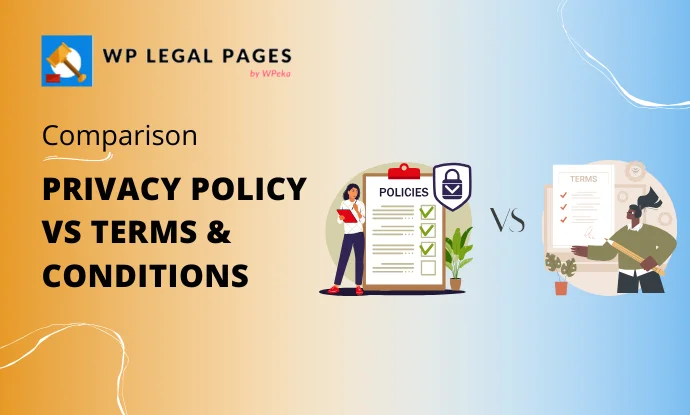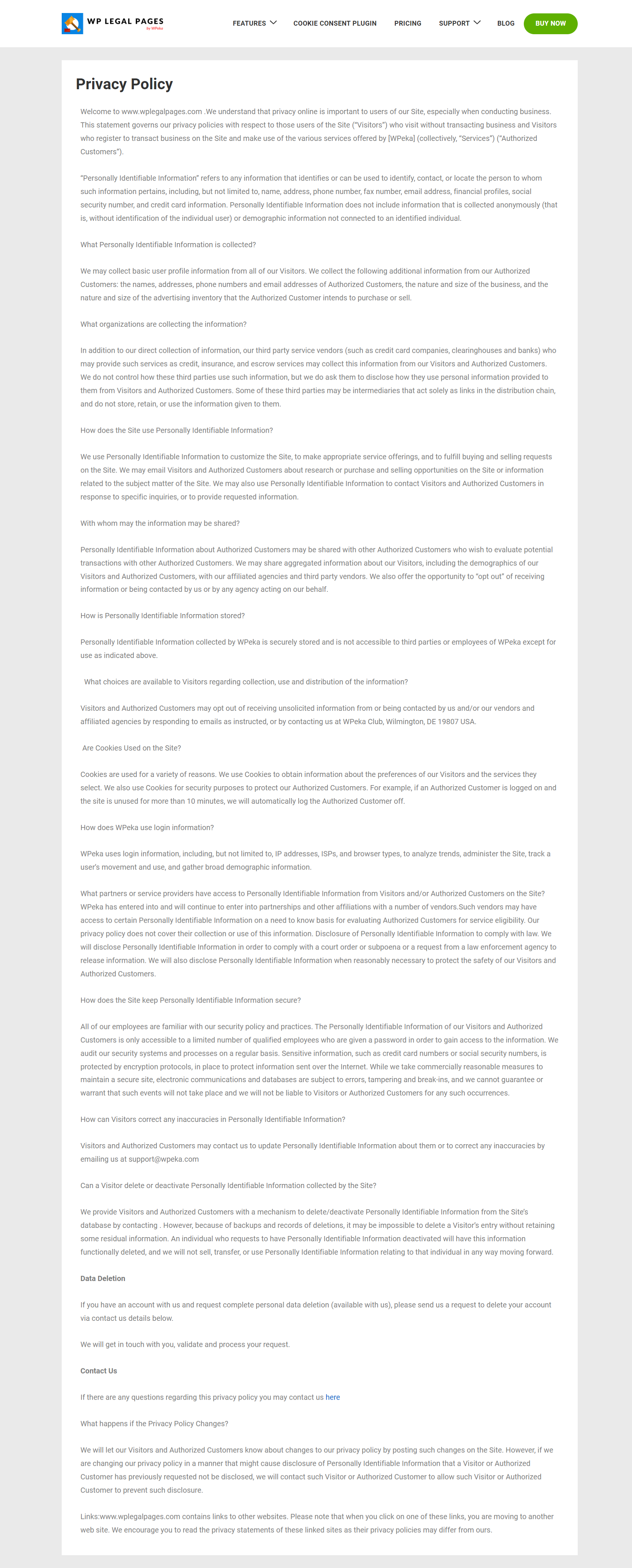Privacy Policy vs Terms And Conditions – An Ultimate Guide

When you hit “I Agree” on a website, have you ever wondered what happens to your personal data on that platform? Want to understand Privacy Policy vs Terms and Conditions?
Privacy Policies and Terms and Conditions are the legal documents you may need to include for any business or website.
By law, a privacy policy must be included on your website whenever you collect user data. The Terms and Conditions document safeguards your intellectual property, sets clear expectations, and establishes boundaries for your business by providing legal guidelines.
In this article, we’ll further explain the differences between the two legal documents and help you decide when to use a privacy policy, a terms and conditions document, or both for your business.
Let’s dive into the article and understand the key differences between both legal documents.
What is Privacy Policy?
By law, if you gather or handle user data for your website, you must provide a Privacy Policy document that enumerates the justifications for your personal data collection.
It’ll demonstrate the purpose of data collection, its intended usage, storage location, and how users can review and change their personal information.
It’ll be a transparent draft to users about how their information is utilized. Users can trust your company this way without worrying about their personal information being misused or used illegally.
There’s a catch, though. You must have a Privacy Policy document indicating that your website, app, or business does not collect personal data from clients, even if you do not collect personal information about them.
Personal data is any information that reveals a person’s identity, such as a full name, e-mail address, license number, date of birth, etc.
Also, the market is filled with numerous Privacy Policy generators. They can help you develop a successful online presence with confidence and clarity.
WP Legal Pages is the best generator to easily create Privacy Policy documentation for our website. It provides 35+ legal policy templates that you may customize to your needs. With just a few clicks, it’ll assist in streamlining the Privacy Policy generation procedure.
Here are a few things you should remember for Privacy Policy agreements:
- Privacy Policies are revised periodically. For example, if you’ve started getting a different kind of personal data from users or if you’ve started giving the data to outside parties,
- Wherever you decide to show it, make sure the Privacy Policy agreement is on a different page.
- Be transparent and showcase accurate information to users, instilling trust.
- Include the keyword “Privacy” in your document’s title and the internal links that link to your page.
- Depending on the locations in which your website operates, you must follow numerous international rules, such as GDPR, CPRA, CCPA, and COPPA.
Privacy Policy Example
Let’s look at the WP Legal Pages website’s sample Privacy Policy.

What are the Terms and Conditions?
Terms and Conditions (T&C), often known as Terms of Service or Terms of Use, are legal agreements whose name is less significant than their contents.
T&C refers to rules and regulations that users must follow when using your services. It outlines the rules, norms, and requirements for using a service, website, or app.
Also, set expectations for users’ services and conduct. As a website owner, this will help limit your legal liability. Without having this kind of agreement in place and not properly enforcing it, you won’t be able to legally restrict who can or cannot use your website or app.
Additionally, the market is filled with numerous Terms and Conditions generators. They can help you develop a successful online presence with confidence and clarity.
WP Legal Pages is the best generator for easily creating our website’s Terms and Conditions page. It provides 35+ legal policy templates that you may customize to your needs. With just a few clicks, it’ll assist in streamlining the T&C procedure.
Here are a few things you should remember for Terms and Conditions agreements:
- You must follow the rules; failing to do so will result in penalties
- Although not required, we advise you to post the T&C page on your website since it’ll limit your liabilities.
- You must exercise caution regarding the security measures you use on your website.
- If your business has a refund policy, you should also state that.
- You must mention which national and/or state laws apply to your business.
Terms and Conditions Example
Let’s look at the CyberChimps Inc. website’s sample Terms and Conditions template.

Privacy Policy vs Terms and Conditions Differences
A Privacy Policy protects your users, while a Terms and Conditions document safeguards your company. This is the main distinction between the two documents.
Even if these two documents have a lot in common, the main distinctions can be summarized as follows:
| Privacy Policy | Terms and Conditions |
| Safegaurds your users | Safeguards your business and website |
| It’s necessary to be included by law | Not a necessity, but it helps limit legal liability |
| It includes data collection, user rights, user data protection, cookie policy, data security, etc | It includes refund policy, governing law, DMCA notices, copyright notices, age requirements, etc |
| Showcases collection, usage, and storage of user data | Showcases ground rules, guidelines, and expectations for your website |
| It mentions any information about international data transfers | It may mention terms about international payments and shipments based on the business’s capability |
| Enforced by law | Enforced by the business owners |
| Describes your rights to access and remove your personal data. | Describes how to stop or terminate your subscription or account. |
Are Both Privacy Policy and Terms and Conditions Required?
If you have two different legal agreements, the Privacy Policy and Terms & Conditions agreements should always be kept apart.
You should draft two distinct legal agreements, even though they may refer to each other, and a privacy provision in the T&C agreement that links to the Privacy Policy.
The link name must incorporate the word “Privacy” in compliance with CPPA and other legal prerequisites. By keeping these agreements apart, users can conveniently peruse both legal documents and readily understand the existence of multiple legal agreements. This separation facilitates user comprehension and awareness.
Privacy policies necessitate numerous special clauses. Integrating these clauses into Terms and Conditions can render the resulting agreement excessively burdensome for readers to navigate.
Thus, maintaining a distinction between the two agreements ensures that users can digest the information more comprehensively and with greater ease.
Consider creating distinct documents instead and then connecting them.
Add a mention of your Privacy Policy in your Terms and Conditions, along with a link, and vice versa. This way, your users would know to read both without becoming overwhelmed by details.
Conclusion
A Privacy Policy and Terms and Conditions agreement is safer for you and legally needed when operating an online business or website. A Terms and Conditions agreement is not legally needed, but a Privacy Policy is.
While a Privacy Policy informs consumers how you will handle their personal information, a Terms and Conditions agreement describes how users can engage with your site or service.
Both documents are crucial for your site. To facilitate easy location for your users, ensure proper marking and easy accessibility of these policies.
Lastly, confirm that you safeguard your business interests and abide by international laws like GDPR and CCPA.
Want to read more articles related to this topic? Then don’t forget to check out the following articles:
- Best Terms And Conditions Generators – A Detailed Review
- Do I Need A Privacy Policy For My Website? – A Beginner’s Guide
- How to Create Terms of Use Policy for the Website
Are you excited to create legal pages for your website easily? Grab WP Legal Pages now!
